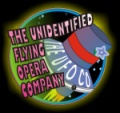
| home | perfection | past performances | company | events | ticket booth | information |

|
The Unidentified Flying Opera Company: Perfection |
|
| home | perfection | past performances | company | events | ticket booth | information | |
|
Perfection: A Space Opera In One Act
|
|
Perfection: A Space Opera in One Act premiered at the Kennedy Center for the Performing Arts on April 4, 1995, as a featured performance of the "Arts Are Magic" Festival, sponsored by Washington Very Special Arts. The opera has been subsequently performed in both private and public schools throughout the Greater Washington area. During the summer of 1995, Montgomery County Public Schools Television, "Your Education Channel," produced Perfection: A Space Opera in One Act for cable television where it is broadcast frequently on Montgomery Cable Channel 60. Perfection is true opera. The words are sung, not spoken. True to form that it is, however, Perfection is also truly accessible. The songs reflect a variety of musical styles and traditions, and were written for children to enjoy. That the Unidentified Flying Opera Company features artists of unsurpassed musical talent is evident to anyone who sees Perfection. It must be noted in addition, however, that the members of the company are also of great humanity, believing in the creative potential of every human being and the perfecting power of love--major themes of the opera. Children who face unusual challenges are especially encouraged to participate in this program. |
|
The story takes place far, far away on the planet Yo-yo. Yo-yo rolls up and down in the sky like a giant yo-yo. Meteor showers mark its rotational reversal, every second Spring. As is usual for people on Yo-yo, Perfection matures within ten days of her birth into a school-aged child. She has trouble speaking but is received warmly by her new teacher Ms. Oldspecs, her classmates, and the class pet, Pet, a many-headed "blues-bird." One little girl, M'Luna, gives Perfection her rubber-band ball. To everyone's astonishment and joy, Perfection can speak perfectly so long as she holds it. A pirate space-captain, Dangerous Phil, intrudes on the class. He steals many things, including Perfection's rubber-band ball. He kidnaps Perfection, taking her with him to his spaceship. Phil's ship is destroyed in a meteor storm. Phil and Perfection return to the class. Perfection reveals what she has learned--the true identity of the pirate captain. |
|
|
The Perfection Virtual Media Museum
|
| home | past performances | company | events | ticket booth | information |